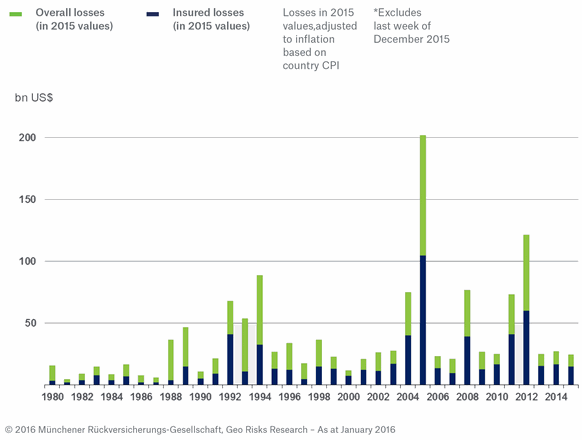That may be about to change and we'll have more on this throughout the year.
For now, a look back via Artemis:
Losses from natural catastrophes in 2015 resulted in just $27 billion of impact to the insurance and reinsurance industry, according to Munich Re, lower than the figure seen in 2014 and the lowest since 2009.
Global reinsurance firm Munich Re noted this morning that the re/insurance sector will find no solace in catastrophe loss figures for 2015 once again, as the continued low levels of financial impact mean there is little stimulus to raise rates.

Of course lower losses is good for society, meaning a lower impact to lives and livelihood from natural disasters and severe weather events. But for the reinsurance industry which is battling with continued rate softening, as seen at the latest January reinsurance renewals, the lack of catastrophes has exacerbated the rate decline and helped to ramp up competition due to high levels of excess capital in the industry....MORE
However the reduction in insured losses has outpaced the decline in economic losses from natural catastrophes in 2015, suggesting that losses have occurred in regions with lower insurance penetration. The ideal scenario is to bring the insurance loss figure as close to the economic loss as possible, ensuring more lives and livelihoods are protected.
“In terms of financial losses, we were somewhat fortunate in 2015: Strong tropical cyclones frequently only hit sparsely populated areas or did not make landfall at all. In the North Atlantic, El Niño helped to curtail the development of heavy storms. Measures to reduce loss susceptibility have also had a positive effect,” Peter Höppe, Head of Munich Re’s Geo Risks Research Unit explained.
El Niño resulted in reduced hurricane activity in the North Atlantic, but at the same time brought major floods and heatwaves to many developing and emerging countries. However, as El Niño conditions wane it is possible that insurers and reinsurers may see an uptick in events that do cause greater losses.
Höppe continued; “Scientists believe that in the coming year the strong El Niño phase might be followed by its twin sister, La Niña. Both versions of the climate oscillation ENSO (El Niño/Southern Oscillation) in the Pacific influence weather extremes throughout the world. A La Niña phase would promote the development of hurricanes in the North Atlantic, for example.”
Munich Re provides some data on 2015’s catastrophe losses:
- 2015 saw the lowest losses of any year since 2009. Overall losses totalled US$ 90bn (previous year US$ 110bn), of which only US$ 27bn (US$ 31bn) was insured.
- The loss amounts were also below the long-term inflation-adjusted average for the period 1985–2014 (overall losses US$ 130bn, insured losses US$ 34bn). Insured losses were therefore roughly 20% below the average.